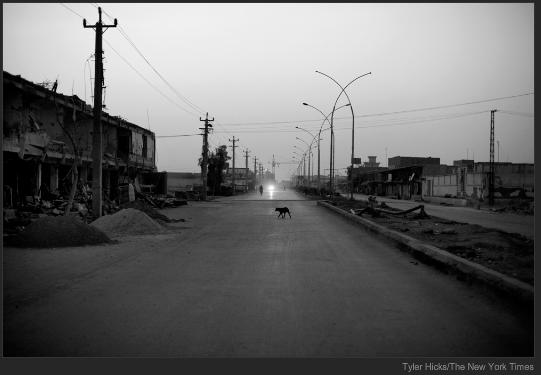The Slow Fall of Kandahar
BY Herschel SmithIn recently released article Why are we in the Helmand Province? I a argued for the legitimacy of the Marines’ presence in the Helmand Province, contra the pronouncements of the population-centric counterinsurgency proponents who wish to deploy U.S. troops to population centers such as Kabul, Kandahar, Herat and Jalalabad. We must go where the insurgents recruit, train, raise their largesse and take safe haven.
Greyhawk at the Mudville Gazette later discussed the fact that we mustn’t let Kandahar become like the cities in Anbar, Iraq, controlled by the insurgents, before we take action (to which I responded on one issue raised by Greyhawk in Insufficient Numbers of Marines). But the fall of Kandahar is proceeding apace, and my arguments for deploying U.S. Marines in the Helmand Province are not to be construed as arguments against deploying them in Kandahar, as sufficient numbers of Marines are available to accomplish both.
Tyler Hicks is reporting from Kandahar, and the streets are anything but secure and bustling with trade.

Tyler Hicks has three rules when photographing in a dangerous, unstable city like Kandahar, Afghanistan. Keep moving, watch the crowd and always listen to your translator and driver.
“It doesn’t matter where you are in the city — there’s always a possibility that you’re moments away from being killed,” said Mr. Hicks, 40, who has been working in Afghanistan for The New York Times since 2001. “So you shave off risk anywhere you can. It’s that bad.”
Kandahar, in southern Afghanistan, was the Taliban’s headquarters from the mid-1990s until its overthrow in 2001. Today, Islamic militants are once again operating inside the city, planting roadside bombs, almost daily, and carrying out a number of suicide attacks.
Mr. Hicks prefers working early in the morning when there are fewer people on the street, dressed in traditional clothing and traveling in a car. He often photographs from the window or limits his time on the street to just minutes, but is still able to create images with a startling intimate feel.
“Working is very difficult because no matter how much you try to fit in, once you get out of the car with your cameras, you’re identified and faced with a lot of unfriendly stares,” Mr. Hicks said.
Kandahar doesn’t see or interact with many foreign troops. In fact, Michael Yon also reports from Kandahar on just what happens with the troops based around Kandahar.
Slowly, surely, the city is being strangled. Signaling the depth of our commitment, security forces are thinner in Kandahar than the Himalayan air. During the days and evenings, there were the sounds of occasional bombs—some caused by suicide attackers, and others by firefights. The windows in my room had been blown out recently and now were replaced. We came here to kill our enemies, but today we want to make a country from scratch …
An American convoy of MRAPs approached from the front and a soldier in the lead vehicle shot a pen-flare, causing everyone to pull off the road. The convoys are more menacing from the outside and in fact I kept the camera down and this is exactly why Secretary of Defense Robert Gates is concerned about adding too many troops. Can’t argue with his reasoning; convoys and troops truly are menacing despite that U.S. and British soldiers are very disciplined. It must look far worse to Afghans. Most Afghans never talk with foreign soldiers and those who do normally only see us in passing. In fact, most soldiers never leave base. Our forces at KAF (Kandahar Airfield) have a base so large that this commercial jet is about to land there after flying dangerously over this unsecured road.
It isn’t the number of troops that’s the problem, it’s what they are doing. More correctly, the number of troops is the problem in that there aren’t enough of them to secure Afghanistan, but the ones who are there are doing the wrong things. So there are two large problems, and both need to be fixed in order to be successful.
Kandahar is badly in need of two or three U.S. Marine Regimental Combat Teams with Air Task Force support. There is a need for Army mechanized troops – perhaps in other parts of Afghanistan, but the debate between mechanized and foot-borne (or dismounted) soldiering is more than merely academic. Kandahar badly needs to see troops. Afghans in Kandahar need aggressive policing. They need to speak with troops, observe them patrol every day, and feel the protection afforded by Marines with rifles who will fire them at the Taliban. They need to see the Afghan National Police teamed up with the Marines and interacting with the people rather than tearing out through the city aboard trucks like Yon observed.
Kandahar needs to be a dismounted campaign. Living on large mega-bases and patrolling in vehicles just won’t do. No protection from the Taliban is afforded by Soldiers in MRAPs, and no policing and population control can be conducted from the seat of a vehicle, any more than intelligence can be gleaned from mounted patrols. Kandahar is slowly falling to the Taliban, and the only alternative to ceding this human and physical terrain to the enemy is aggressive, large scale troop presence conducting dismounted patrols. But for the patrols to be effective, General McChrystal’s tactical directive limiting fires in certain situations must be rescinded. The Marines and smart and adaptable, and don’t need McChrystal’s advice, as they have been doing and winning counterinsurgencies longer than has McChrystal. The good general is trying to teach his granny to suck eggs.





No comments yet.
RSS feed for comments on this post. TrackBack URL
Leave a comment